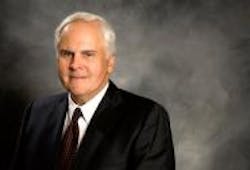“When you consider that light-duty electric vehicles have a per mile cost of operation 70% to 80% lower than petroleum-powered light duty vehicles, those are numbers that really get your accountant’s attention.” –Frederick Smith, chairman, president and CEO, FedEx Corp.
FedEx’s Fred Smith believes the wholesale electrification of light-duty commercial vehicles is an absolutely vital transportation strategy the U.S. needs to embark on right away, for the most fundamental of reasons.
It’s not because all-electric vehicles (EVs) would help the U.S. transportation sector be “greener” (although that’s nice) by reducing vehicle exhaust pollution, nor is it because EVs can cost a lot less to operate while delivering significant life cycle cost savings for fleets (which is even nicer).
No, Smith boils the needs for EVs in the country down to one single word: survival.
“We [FedEx] got into EVs simple for self-preservation,” he explained during a speech this week in Washington D.C. on behalf of the Electrification Coalition.
“Over half of the oil used by our country is now imported, with most of it coming from unstable regions of the world, from countries that don’t share our values,” he said. “Oil imports also represent 40% of our balance payment problem in the U.S. as well. So oil represents a significant economic and national security issue all in one.”
The group recently unveiled what it dubs a Fleet Electrification Roadmap designed to help formulate policies to improve the economics of electric vehicles for fleet operators; driving much-needed scale production volumes in the U.S. battery industry, thus helping to lower EV costs for fleets and the broader consumer market alike.
Smith said that the biggest benefit with EVs is that the production and distribution infrastructure for this alternative fuel – electricity – already is well established in the U.S., with a number of all-domestic sources of energy able to generate it in the necessary quantities.
“We can use nuclear, coal, solar, geothermal, and hydro-generation to make electricity,” Smith emphasized. “That’s why EVs offer the best option for light-duty commercial vehicles in terms of not just reducing petroleum consumption but reducing emissions and cost of operation as well.
The concern about switching en masse to EVs among fleets and consumers alike, however, doesn’t revolve around whether the projected savings materialize in the expected quantities or not. Rather, the worry about EVs centers squarely on reliability, according to a recent survey by consulting firm Pike Research.
Pike’s poll indicates the “selling points” of reduced emissions and less petroleum consumption may not be enough to overcome key objections among some skeptical consumers – namely, the concerns that EV technology has not yet been proven, and that they may not be reliable as traditional gasoline vehicles.
“The electric vehicle industry has been very focused on addressing so-called driving ‘range anxiety,' the term used to describe consumers’ qualms about the effective range of a plug-in electric vehicle (PEV) on a single charge,” noted Pike senior analyst John Gartner.
“But the fact is that a ‘wait-and-see’ approach about the technology itself was a greater issue for consumers in our survey,” he added. “It could easily take several years for mainstream car shoppers to get comfortable with the idea of electric vehicles.”
Yet Pike senior analyst Dave Hurst pointed out that the “flip side” of this survey was that 44% of respondents stated that they would be “extremely” or “very” interested in purchasing a PEV with a driving range of 40 to 100 miles and an electricity cost equivalent of 75 cents per gallon.
Also, 83% of Pike’s survey respondents drive 40 miles or less in a typical day, making “range anxiety” a non-issue for the majority of prospective PEV drivers.
Still, price sensitivity analysis indicates that automakers will face challenges when marketing PEVs to consumers, as Pike found that the optimal price point (OPP) for PEVs is 18.75% above the base price of a comparable gasoline vehicle; a number, however, that is still significantly lower than automakers’ intended prices.
It just shows that many challenges remain ahead to make EVs a more acceptable alternative to the tried-and-true internal combustion engine fleets and consumers remain more familiar – and comfortable – with.
